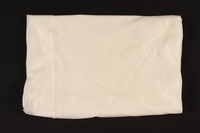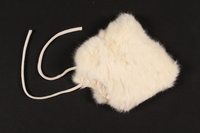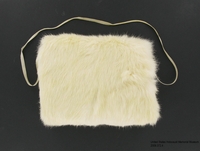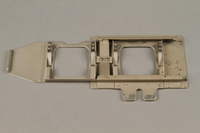Overview
- Description
- Collection of materials documenting the experiences of the Robinson family in the Zeilsheim Displaced Persons (DP) camp and after their immigration to the United States in October 1948. The collection includes a photo album compiled by Ephraim Robinson of the Zeilsheim DP camp.
- Date
-
inclusive:
1945-1948
- Credit Line
- United States Holocaust Memorial Museum Collection, Gift of Alice Robinson Lev
Physical Details
- Genre/Form
- Photograph albums.
- Extent
-
1 oversize box
Rights & Restrictions
- Conditions on Access
- There are no known restrictions on access to this material.
- Conditions on Use
- The donor, source institution, or a third party has asserted copyright over some or all of these material(s). The Museum does not own the copyright for the material and does not have authority to authorize use. For permission, please contact the rights holder(s).
- Copyright Holder
- Mrs. Alice R. Lev
Keywords & Subjects
- Corporate Name
- Zeilsheim (Displaced persons camp)
Administrative Notes
- Holder of Originals
-
United States Holocaust Memorial Museum
- Legal Status
- Permanent Collection
- Provenance
- Received and created by members of the Robinson family in the Zeilsheim displaced persons camp and Milwaukee, Wisconsin, 1945-1948. Donated to the United States Holocaust Memorial Museum in 2009 by Alice Robinson Lev.
- Record last modified:
- 2024-03-13 13:18:09
- This page:
- https://collections.ushmm.org/search/catalog/irn40075
Download & Licensing
- In Copyright
- Terms of Use
- This record is not digitized and cannot be downloaded online.
In-Person Research
- Request 7 Days in Advance of Visit
- Plan a Research Visit
-
Request in Shapell Center Reading Room
Bowie, MD
Contact Us
Also in Ephraim Robinson family collection
The collection consists of children's clothing, a duvet cover, a glass slide projector, glass slides, and a photograph album relating to the experiences of Ephraim Robinson and his family as refugees during the Holocaust, as residents of Zeilsheim displaced persons camp in Germany, and as immigrants to the United States in the postwar period.
Date: 1945-1948

Duvet cover made from a US Army parachute by a Jewish family in a displaced persons camp
Object
Covering for a blanket made from a United States Army parachute by Ephraim and Sarah Robinson for their family in the Zeilsheim displaced persons camp in Germany, where they lived from 1945-1948. Soon after Nazi Germany invaded Poland in September 1939, Ephraim and Sarah fled east to Russian controlled territory. They lived in several places as the Soviet Union demanded that Jewish refugees keep moving further east. They had a daughter, Fay, in 1941, in Odessa, and Alice was born in 1944 in Romanovka. When the war ended in May 1945, they returned from Uzbekistan to Bessarabia, where they crossed the border to Poland. In October 1945, they were relocated to Zeilsheim, with the assistance of the Hebrew Immigrant Aid Society. Ephraim, Sarah, and their 3 children, Fay, Alice, and Joseph, born in the camp in 1946, got passage on the first immigrant transport to depart under the Displaced Persons Act, the SS General Black, which arrived in the United States on October 30, 1948.

Child's white rabbit fur bonnet received in a displaced persons camp
Object
White rabbit fur bonnet worn by two year old Alice Robinson, in the Zeilsheim displaced persons camp in Germany, where she lived from 1945-1948. Alice's parents, Ephraim and Sarah had left Poland soon after September 1939, when it is occupied by Nazi Germany. They fled east to Russian controlled territory where the Soviet Union demanded that Jewish refugees keep moving further east. They had a daughter, Fay, in 1941, in Odessa, and Alice was born in 1944 in Romanovka. When the war ended in May 1945, they returned from Uzbekistan to Bessarabia, where they crossed the border to Poland. In October 1945, they were relocated to Zeilsheim, with the assistance of the Hebrew Immigrant Aid Society. Ephraim, Sarah, and their 3 children, Fay, Alice, and Joseph, born in the camp in 1946, got passage on the first immigrant transport to depart under the Displaced Persons Act, the SS General Black, which arrived in the United States on October 30, 1948.

Child's white rabbit fur hand muff received in a displaced persons camp
Object
White rabbit fur hand muff worn by Alice Robinson, age 2, in the Zeilsheim displaced persons camp in Germany, where she lived from 1945-1948.Alice's parents, Ephraim and Sarah had left Poland soon after September 1939, when it is occupied by Nazi Germany. They fled east to Russian controlled territory where the Soviet Union demanded that Jewish refugees keep moving further east. They had a daughter, Fay, in 1941, in Odessa, and Alice was born in 1944 in Romanovka. When the war ended in May 1945, they returned from Uzbekistan to Bessarabia, where they crossed the border to Poland. In October 1945, they were relocated to Zeilsheim, with the assistance of the Hebrew Immigrant Aid Society. Ephraim, Sarah, and their 3 children, Fay, Alice, and Joseph, born in the camp in 1946, got passage on the first immigrant transport to depart under the Displaced Persons Act, the SS General Black, which arrived in the United States on October 30, 1948.

Leitz glass slide projector with case, trays, and key ring used in a displaced persons camp
Object
Leitz projector for glass slides with case, trays, and a key ring used by Ephraim Mayer Robinson to view photographs that he took of activities in Zeilsheim displaced persons camp in Germany from 1945-1948. Soon after Nazi Germany invaded Poland in September 1939, Ephraim and his wife, Sarah, fled east to Soviet territory. They relocated often as the Soviet Union demanded that Jewish refugees keep moving further east. They had a daughter, Fay, in 1941, in Odessa, and Alice was born in 1944 in Romanovka, Bessarabia. When the war ended in May 1945, they returned from Uzbekistan to Bessarabia, where they crossed the border to Poland. In October 1945, they were relocated to Zeilsheim, with the assistance of the Hebrew Immigrant Aid Society. Ephraim, Sarah, and their 3 children, Fay, Alice, and Joseph, born in the camp in 1946, got passage on the first immigrant transport to depart under the Displaced Persons Act, the SS General Black, which arrived in the United States on October 30, 1948.

Ephraim Robinson color slides
Document
Collection of materials documenting the experiences of the Robinson family in the Zeilsheim Displaced Persons (DP) camp and after their immigration to the United States in October 1948. The collection includes: a photo album compiled by Ephraim Robinson of the Zeilsheim DP camp, Agfacolor 35mm color film transparencies in a wooden box taken by Ephraim Robinson of the Zeilsheim DP camp and in Milwaukee, Wisconsin, slide projector brought by Ephraim Robinson from Germany to the United States, a duvet cover made from an American parachute, and a rabbit fur hat and muff worn by Alice Robinson in the Zeilsheim DP camp; collection dated 1945-1948.



